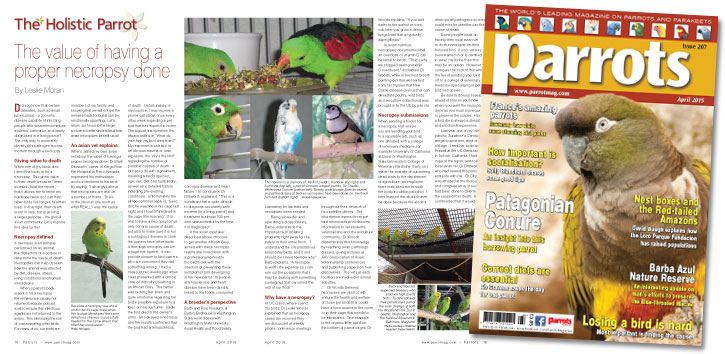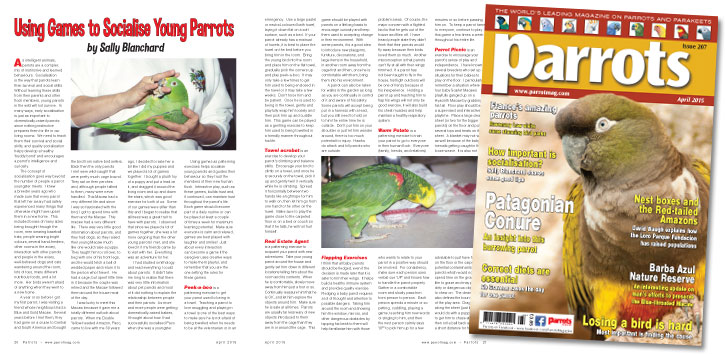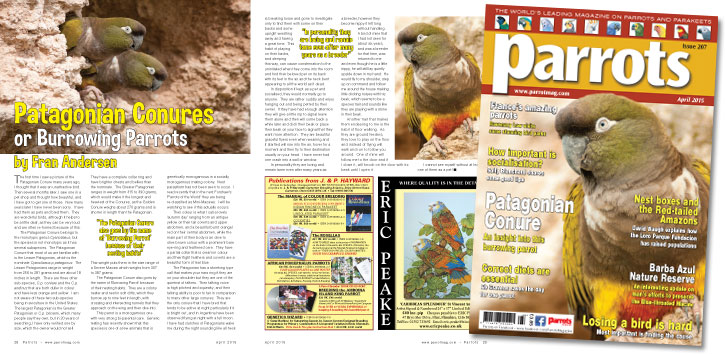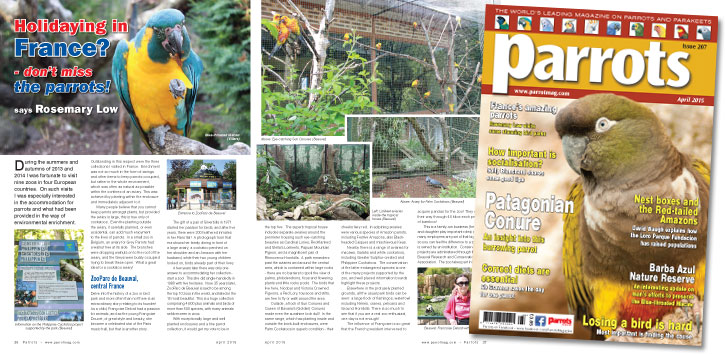
By Leslie Moran
Did you know that certain diseases, such as avian tuberculosis - a zoonotic disease capable of infecting people with weakened immune systems, cannot be accurately diagnosed in a living parrot? The only way to accurately identify this pathogen is post-mortem through a necropsy.
When one of my birds dies I send the body in for a necropsy. This gives value to their death because I learn so much from the report that it allows me to refine my nutritional work so I can help other birds live longer, healthier lives. In this light, their death is not in vain, but is serving a larger purpose - the global avian community. Let’s explore this idea further.
Buy Now!

By Sally Blanchard
As intelligent animals, parrots are a complex mix of instinctive and learned behaviours. Socialisation is the way that parrots learn their survival and social skills. Without learning these skills from their parents and other flock members, young parrots in the wild will not survive. In many ways, early socialisation is just as important to domestically-raised parrots since nothing instinctive prepares them for life in our living rooms. We need to teach them their survival and social skills, and quality socialisation helps develop a healthy 'buddy bond' and encourages a parrot’s intelligence and curiosity.
The concept of socialisation goes way beyond the number of people a parrot youngster meets. I knew a breeder years ago who made sure that every parrot that left her aviary had safely experienced many things that otherwise might have upset them in a new home. This included boxes of many sizes being brought through the room, men wearing baseball hats, people wearing bright colours, several hand-feeders, other rooms in the aviary, interaction with other parrots and people in the aviary, well-behaved dogs and cats wandering around the room, lots of toys, many different nutritious foods, and a lot more. Her birds weren’t afraid of anything when they went to a new home.
Buy Now!

By Fran Andersen
The first time I saw a picture of the Patagonian Conure many years ago, I thought that it was an unattractive bird. Then several months later, I saw one in a pet shop and thought how beautiful, and I have got to get one of those. Now many years later I have never been sorry. I have had them as pets and bred them. They are wonderful birds, although it helps to be a little deaf, as they can be very loud and are often re-homed because of this.
The Patagonian Conure belongs to the monotypic genus Cyanoliseus, but the species is not monotypic as it has several subspecies. The Patagonian Conure that most of us are familiar with is the Lesser Patagonian, which is the nominate Cyanoliseus p patagonus. The Lesser Patagonians range in weight from 256 to 281 grams and are about 18 inches in length. There are three other sub-species, C.p. conlara and the C.p. andinus that are both duller in colour and have less orange and yellow. I am not aware of these two sub-species being in aviculture in the United States. The largest Patagonian is the Greater Patagonian or C.p. bloxami, which many people say they own, but in 20 years of searching, I have only verified one by size, which the owner would not sell.
Buy Now!

Rosemary Low
During the summers and autumns of 2013 and 2014 I was fortunate to visit nine zoos in four European countries. On such visits I was especially interested in the accommodation for parrots and what had been provided in the way of environmental enrichment.
Outstanding in this respect were the three collections I visited in France. Enrichment was not so much in the form of swings and other items to keep parrots occupied, but rather in the whole environment, which was often as natural as possible within the confines of an aviary. This was achieved by planting within the enclosure and immediately adjacent to it.
Many people believe that you cannot keep parrots amongst plants, but provided the aviary is large, this is true only of cockatoos. Even the planting outside the aviary, if carefully planned, or even accidental, can add much enjoyment to the lives of parrots. In a small zoo in Belgium, an aviary for Grey Parrots had a walnut tree at its side. The branches were dropping walnuts on to the roof of the aviary, and the Greys were busily occupied trying to break these open. What a great idea for a cockatoo aviary!
Buy Now!




